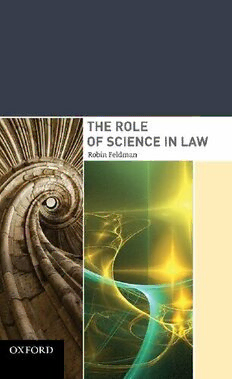
The Role of Science in Law PDF
Preview The Role of Science in Law
The Role of Science in Law This page intentionally left blank The Role of Science in Law Robin Feldman 1 1 Oxford University Press, Inc., publishes works that further Oxford University’s objective of excellence in research, scholarship, and education. Oxford New York Auckland Cape Town Dar es Salaam Hong Kong Karachi Kuala Lumpur Madrid Melbourne Mexico City Nairobi New Delhi Shanghai Taipei Toronto With offi ces in Argentina Austria Brazil Chile Czech Republic France Greece Guatemala Hungary Italy Japan Poland Portugal Singapore South Korea Switzerland Thailand Turkey Ukraine Vietnam Copyright © 2009 by Oxford University Press, Inc. Published by Oxford University Press, Inc. 198 Madison Avenue, New York, New York 10016 Oxford is a registered trademark of Oxford University Press Oxford University Press is a registered trademark of Oxford University Press, Inc. All rights reserved. No part of this publication may be reproduced, stored in a retrieval system, or transmitted, in any form or by any means, electronic, mechanical, photocopying, recording, or otherwise, without the prior permission of Oxford University Press, Inc. _____________________________________________ Library of Congress Cataloging-in-Publication Data Feldman, Robin. The role of science in law / Robin Feldman. p. cm. Includes bibliographical references and index. ISBN 978-0-19-536858-1 ((hardback) : alk. paper) 1. Science and law--United States. 2. Technological innovations--Law and legislation--United States. I. Title. KF385.F45 2009 344.73’095--dc22 2008042085 _____________________________________________ 1 2 3 4 5 6 7 8 9 Printed in the United States of America on acid-free paper Note to Readers This publication is designed to provide accurate and authoritative information in regard to the subject matter covered. It is based upon sources believed to be accurate and reliable and is intended to be current as of the time it was written. It is sold with the understanding that the publisher is not engaged in rendering legal, accounting, or other professional services. If legal advice or other expert assistance is required, the services of a competent professional person should be sought. Also, to confi rm that the information has not been affected or changed by recent developments, traditional legal research techniques should be used, including checking primary sources where appropriate. (Based on the Declaration of Principles jointly adopted by a Committee of the American Bar Association and a Committee of Publishers and Associations.) You may order this or any other Oxford University Press publication by visiting the Oxford University Press website at www.oup.com This book is dedicated to my husband Boris and our children Natalie, Talya, Eli, Sam, and Adam. It is also dedicated to Professors Bob Weisberg and Gerry Gunther, to whom I will always be grateful for their inspiration This page intentionally left blank Contents Acknowledgments ix Abstract xi CHAPTER I The Allure of Science 1 CHAPTER II Internalization of Science in Modern Law 19 A. Abortion 21 B. Copyright 23 C. Gene Patents 27 CHAPTER III Externalization in Modern Law 37 A. Environmental Regulation 39 B. Antitrust 41 CHAPTER IV The Repetitions of History 49 A. Legal Theory Movements 50 B. Doctrinal Examples 68 viii CONTENTS CHAPTER V The Nature of Law 79 A. Bounded Adaptation 85 B. Is There Something Different About Law Related to Technology? 90 C. The Mismatch of Law and Science 94 CHAPTER VI What is Science? 97 A. Science in Ancient History 101 B. The Separation of Science 109 C. Science Confronted and Confounded 120 D. An Uneasy Truce 133 CHAPTER VII Misunderstanding the Limits of Science 139 A. Problems in Translation 141 B. The Changing Nature of Law and Science 152 C. The Inclusion of Social Science 155 CHAPTER VIII Improving the Role of Science in Law 159 A. Operating Within Law’s Parameters 160 B. Testing and Transformation 170 C. Protecting the Structure of the Dialogue 174 D. The Embrace of Imperfection 195 CHAPTER IX Conclusion 199 Table of Cases 201 Index 209 Acknowledgments I am grateful to Vik Amar, Margreth Barrett, Richard Epstein, David Faigman, Robert Gordon, David Jung, Sonia Katyal, Donald Kennedy, Greg Kline, Evan Lee, Jeff Lefstin, Mark Lemley, David Levine, Roger Park, Reuel Schiller, Bill Simon, Chris Slobogin, and Lois Weithorn. I am also tremendously grateful to the Chip Robertson Research Fund for support of the project. I wish to thank Cassandra Christiansen, David DeVito, Adam Engelhart, Evgeni Halavanau, Daniel Leroux, Lisa Li, William Mullen, Sudhir Pala, Serena Sanders, Dominic Signorotti, Phong Wu, Brandon Yasnogorodskiy, and Brandon Yu for their research assistance. I am particularly grateful to Mike Dean and James Beard, not only for research assistance but also for coordinat- ing the efforts of the research team. I am indebted beyond measure to Linda Weir, U.C. Hastings Public Services Librarian. I also wish to thank John A. Collins, Lamont Research Services, Harvard University. Finally, I wish to thank participants in the Annual Intellectual Property Scholars’ Conference, the Chicago Intellectual Property Colloquium, and the Stanford Program in Law, Science, and Technology for their comments. Earlier versions of selected
